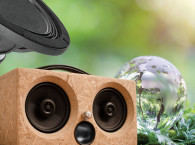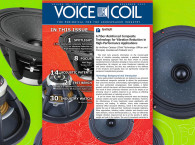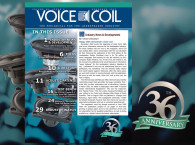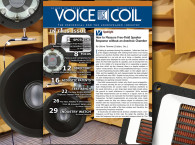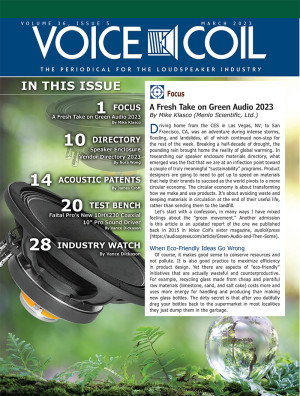 For this issue of Voice Coil, Mike Klasco (Menlo Scientific) shares his experience dealing with good intentions for sustainability, circularity, or simply reducing your carbon foot-print in the development or manufacturing stages. On "A Fresh Take on Green Audio 2023", he reminds us how things are not always as simple as we would like, and that having good intentions and throwing empty claims might work on paper, but not actually work in the real world. And there's nothing better than reading this valuable article to avoid some typical pitfalls, and learn how to actually go about with being green and sorting a sustainable strategy for audio products.
For this issue of Voice Coil, Mike Klasco (Menlo Scientific) shares his experience dealing with good intentions for sustainability, circularity, or simply reducing your carbon foot-print in the development or manufacturing stages. On "A Fresh Take on Green Audio 2023", he reminds us how things are not always as simple as we would like, and that having good intentions and throwing empty claims might work on paper, but not actually work in the real world. And there's nothing better than reading this valuable article to avoid some typical pitfalls, and learn how to actually go about with being green and sorting a sustainable strategy for audio products.This topic was actually inspired by this issue's focus, on speaker cabinets and enclosures, an area that is particularly at an inflection point toward meaningful sustainability. That might be from sourcing sustainably harvested woods, researching new materials and trying recyclable solutions, or go all the way towards inventing completely new solutions that can be maintained and reused. And there's a bit of all that in the complete and up to date Speaker Enclosure Vendor Directory that Nora Wong compiled for 2023. Looking for a cabinet supplier? The directory lists companies from all over the world, although this is something that might make sense to source closer to home as the first step in being "green".
At the core of this March issue of Voice Coil, we are certain that our readers will be absolutely fascinated with the depth of another Acoustic Patents review by James Croft (Croft Acoustical). This time, the focus for his column was a patent filed and recently awarded to Yamaha Corporation. The patent is simply titled "Acoustic Apparatus," which doesn't reveal much about how significant it could be. The inventors listed are Yohei Ohtani and Masao Noro, both from Japan, and the patent was published just in January of 2023.
The abstract details the use of a Class-D amplifier and current feedback circuit, driving the voice coil of a speaker. The speaker system is configured such that, in a case where the speaker system is driven by an ordinary amplifier having a first output resistance lower than a second output impedance of the Class-D amplifier, the current feedback circuit increases the second output impedance of the Class-D amplifier by feeding a current back to the voice coil to increase the Q factor. This is effectively a way to bend the infamous "Hofmann’s Iron Law." Yes, it's been done before, but as always there are always ways to do better.
The invention under review is an active loudspeaker system wherein the loudspeaker BL is increased to reduce the Qt of the system and increase upper range sensitivity and overall potential efficiency. A Class-D amplifier is utilized with the system in a new manner that optimizes the interactive relationship of the amp and loudspeaker to achieve the type of efficiency, bandwidth and required enclosure volume. No speaker designer will want to miss reading this captivating review.
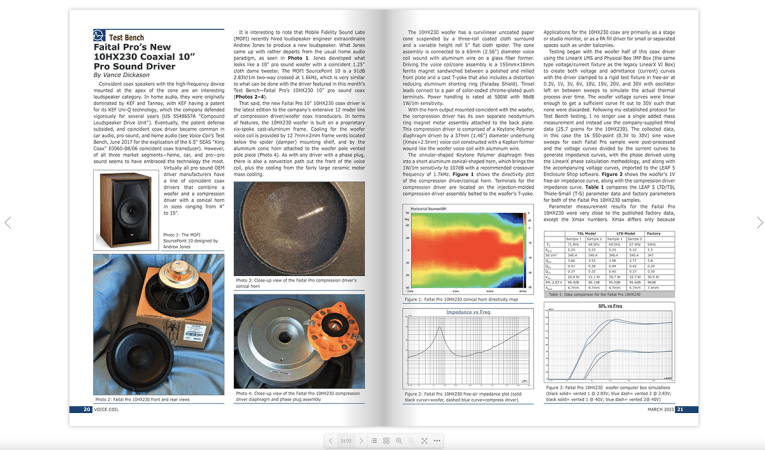
Next up, Vance Dickason takes the new 10HX230 10" coaxial professional driver from Faital Pro to his Test Bench. This is another interesting example in this loudspeaker category, particularly well-received in professional audio applications. Virtually all pro sound OEM driver manufacturers have a line of coincident coax drivers that combine a woofer and a compression driver with a conical horn in sizes ranging from 4" to 15". The new Faital Pro 10" 10HX230 driver is the latest edition to the company’s extensive 12 model coaxial line. The driver is built on a proprietary six-spoke cast-aluminum frame, with cooling for the woofer voice coil provided by 12 vents located below the spider, and by an aluminum conic horn attached to the woofer pole vented pole piece. As with any driver with a phase plug, there is also a convection path out the front of the voice coil, plus the cooling from the fairly large ceramic motor mass cooling.
The 10HX230 has a curvilinear uncoated paper cone woofer, a voice coil with aluminum wire wound on a glass fiber former, driven by a ferrite magnet, and a compression driver driven by a separate neodymium motor attached to the back plate horn mounted coincident with the woofer. This compression driver features a Keytone Polymer diaphragm that fires into the short aluminum conical-shaped horn.
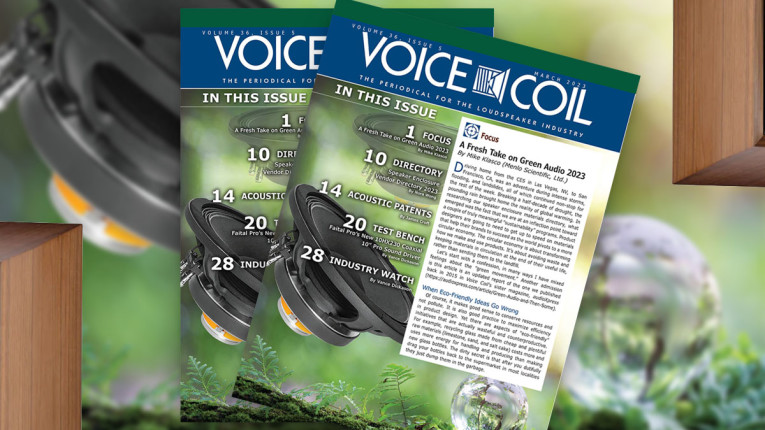
This issue of Voice Coil is available for download and already in the mail to print subscribers. Subscribers can go to - www.gotomyvcoil.com - to download this issue.
Remember, Voice Coil is available in print and download for all registered subscribers, free for industry professionals. To qualify for a free subscription to Voice Coil, or renew your subscription, go to: Voice Coil Subscriber Services.
Access to Digital Subscriptions
The pandemic has affected everyone’s lives, including those who provide our delivery service. With a surge in delivery demands and travel restrictions, we realize some of you may be experiencing significant delays in receiving your magazines. So KCK Media has opened up its digital subscription platform to all print subscribers for no additional fee. To access it, just login using your subscriber number and post/zip code as displayed on your mailing label.



